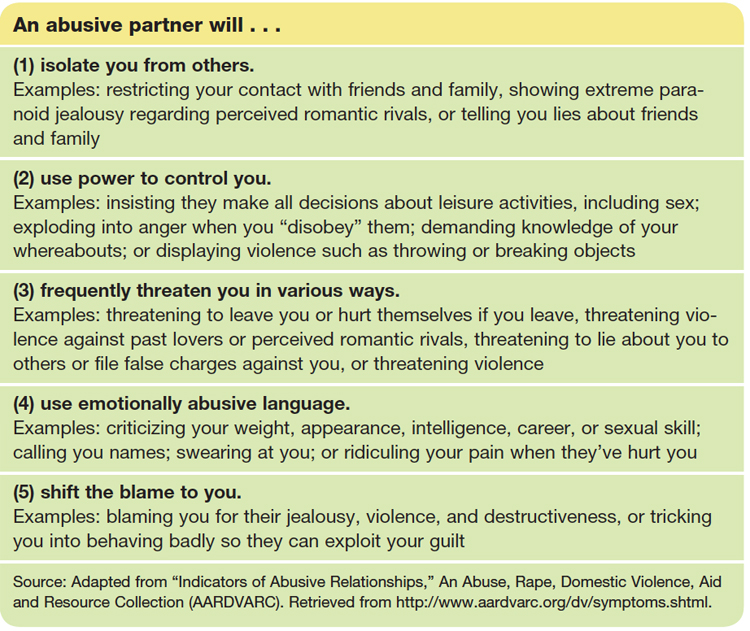9.6.6 Dating Violence
Printed Page 313
Dating Violence
Scott and I became friends in grad school, when we both served as instructors with a campus karate club. Scott was originally from Southern California, where he was a kickboxing champion.7 He was 6 foot 3, all muscle, and had a very long reach—something I learned the hard way when he caught me with an unexpected back-fist on my nose while sparring!
Soon after our friendship began, Scott met Pam, and the two fell for each other hard and fast. But within a few weeks, Scott confessed to me several concerns: Pam was extremely jealous and constantly accused him of cheating. She called him names, swore at him, and ridiculed his sexual performance. She demanded that he no longer go out with his friends, and when he refused, she threatened to leave him. Visiting him one afternoon, I was stunned to see the glass frame of his black-belt certificate shattered. “Yeah,” he admitted, “Pam threw it at me the other night.” When she learned that Scott was confiding in me, Pam told him a series of lies to alienate him from me: I had “stolen money from him,” I had “hit on her,” I was “gay and wanted him to myself” (never mind that the last two were contradictory). But Scott stayed with her until she put him in the hospital with a broken nose and third-degree burns across his face. She had demanded that he quit karate, and when he refused, she had hit him in the face with a heated clothes iron. When I asked why he didn’t fight back, or at least defend himself (given his abundant skills), he looked at me in disbelief. “I can’t hit a girl, man. I’m not that kind of guy!”
Dating violence affects millions of people, and as Scott’s story shows, despite common beliefs, dating violence knows no demographic boundaries: men and women of all ages, sexual orientations, social classes, ethnicities, and religions experience violence in romantic relationships. According to the Centers for Disease Control, by the time students graduate from high school, 10 percent have experienced dating violence, defined as “being hit, slapped, or physically hurt, on purpose, by a boyfriend or girlfriend in the preceding 12 months” (Centers for Disease Control, 2008). Twenty-one percent of college students report having experienced such violence (National Center for Victims of Crimes, 2008). In addition to physical injuries (and in extreme cases, death), victims of dating violence are more likely than others to suffer from substance abuse, low self-esteem, suicidal thoughts, and eating disorders (Ackard & Neumark-Sztainer, 2002).
It’s easy, if you haven’t experienced a violent relationship, to think, “Well, the person should have seen it coming!” But this is false, for at least two reasons (Eisikovits & Buchbinder, 2000). First, violence doesn’t happen all at once—it typically escalates slowly over time. Also, it often doesn’t evolve into full-blown physical violence until relationships are firmly established—making victims all that much more vulnerable, because of their love and commitment. Second, potential abusers often mask their jealousy, violent anger, and excessive need for control in the early stages of a relationship, making it difficult to discern “warning signs” (see Table 9.3 for a detailed list). In Scott’s case, both of these reasons played a role in making him vulnerable. Pam seemed perfectly “normal” in the first few weeks of their relationship. She was funny, attractive, smart, and outgoing. By the time the first incidents occurred, he was already in love. And the destructiveness of her behaviors escalated slowly—starting with minor jealous tantrums, and only evolving into violence after many months. As a consequence, Scott didn’t perceive Pam’s abusiveness as particularly “severe,” until she put him in the hospital.
What should you do if you find yourself in a relationship with a violent partner? First and foremost, let go of the belief that you can “heal” your partner through love, or “save” him or her by providing emotional support. Relationship repair strategies will not prevent or cure dating violence. Your only option is to extricate yourself from the relationship. As you move toward ending the involvement, keep in mind that the most dangerous time comes immediately after you end the relationship, when the abuser is most angry. So, make sure you cut all ties to the abuser, change your phone numbers, and have ready a safety plan: a road map of action for departing the relationship that provides you with the utmost protection. For information on how to develop such a plan, or for help in dealing with an abusive relationship, call the National Domestic Violence Hotline, 1-800-799-SAFE, or visit www.thehotline.org.
Table 9.3 Five Common Warning Signs of an Abusive Partner
